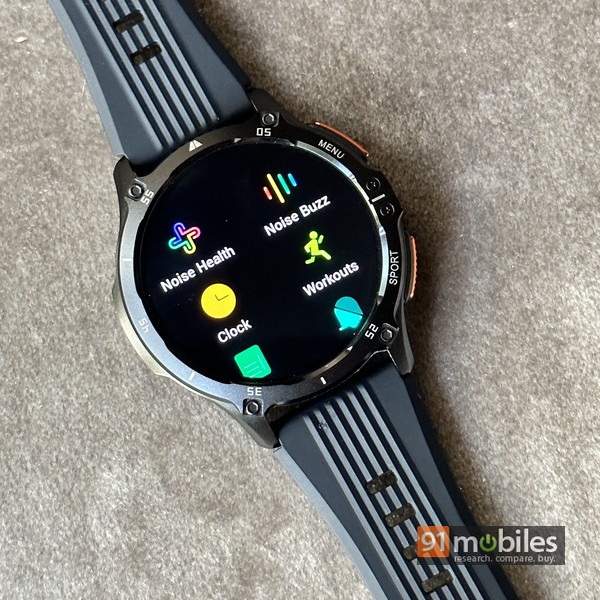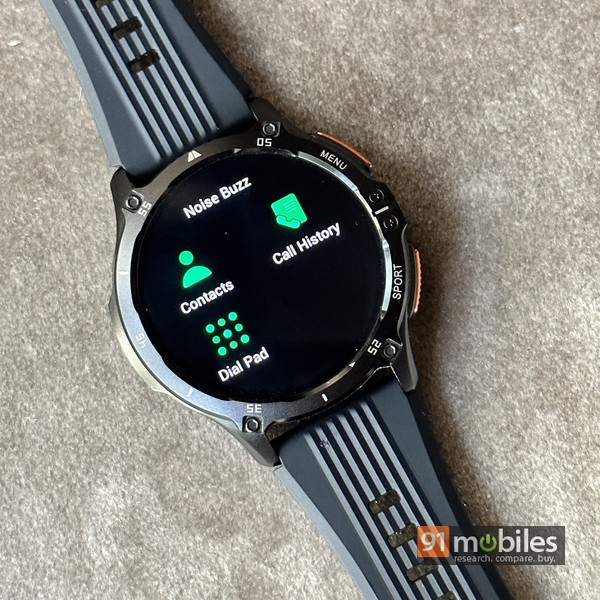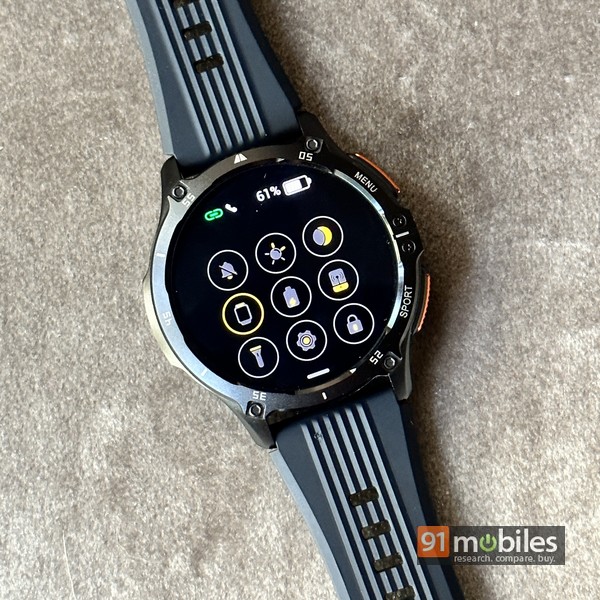Noise is one of the leading names in the fitness watch segment in the country, ranked second as per the latest figures from IDC. The other dominant players include the likes of Boat and Fire-Boltt, and together these brands dominate the affordable league, bombarding the physical and virtual store shelves with frequent launches… with each trying to outdo the other in terms of design and features. Among Noise’s latest offerings is the NoiseFit Force Plus, which carries the label of being a “rugged smartwatch built for extremes and made for thrill-seekers”. I put these claims to the test and here are my findings. Read on for my NoiseFit Force Plus review.
Design and display

The NoiseFit Force Plus’ claim to fame is its rugged look, inspired by the Casio G-Shock range of watches. Noise’s offering does look rather good, especially if you like chunky watches, and stands out in black (other options include grey and blue). The thick metal watch case features prominent design elements and the inclusion of two orange-coloured keys on the right adds to the rugged look.

The device also features IP67 rating for resistance to dust and water. The black rubber strap sports ridges and a design meant to enhance the watch’s rugged look, and while it does that to some extent, I think it’s not extremely comfortable to wear over long hours. Thankfully it uses standard 22m width and quick-release pins and is easy to swap out.

The 1.46-inch circular display is of the AMOLED variety and features a resolution of 466 x 466 pixels and a peak brightness of 550 nits. As such, it’s quite vibrant and easy to read in bright sunlight. I think the touch response could have been a shade better, but otherwise, the display is quite nice overall. The screen supports the Always-on Display (AoD) feature as well, and though you only get to choose between analogue and digital modes for it, comes in quite useful when you quickly want to peek at the time without moving your hand. Apart from the time, it also shows the day and date, battery level and number of steps taken as well. One thing to note is that Noise doesn’t specify if the screen features any kind of protective layer on top, so it might just be the most vulnerable part of the device in case you manage to drop it or otherwise subject it to force or pressure. That said, the raised bezel around the display should protect it to some extent.
Features

As a fitness watch, the NoiseFit Force Plus offers all the basic features one would expect. It can display notifications from a paired smartphone, and offers standard features like alarm, stopwatch, timers, reminders, music control, and weather. As far as health and fitness features are concerned, it can track steps, heart rate, sleep patterns, SpO2, stress, and women’s health too. You also get support for as many as 130 sports modes along with auto workout detection, and the device can track routes using a paired phone’s GPS.

One of the key features boasted by the device is support for voice calling over Bluetooth 5.3. As per Noise, it uses the brand’s Tru Sync tech and a single chip, which makes the connection seamless. While most budget fitness watches that offer voice calling need to be paired twice over Bluetooth to make this feature work, the Force Plus has to be paired just once, making the process hassle-free and quite simple too.
UI and app connectivity

The operation is largely touch and swipe driven. Swiping downward shows notifications while an upward swipe shows quick settings. Swiping sideways cycles through a non-customisable list of widgets — heart rate, SpO2, sleep, stress and one that shows a scrollable summary of your physical activity, alarms, weather and the previously mentioned health metrics in one place. Pressing the button on the right bottom shows the list of added workouts, and the top key brings up the main menu showing the app/functions, and you can choose to see this in a grid view or as a list. The calling functions are clubbed under a menu item labelled “Noise Buzz” while the fitness functions can be found under “Noise Health”. The calling functions under Noise Buzz give you a dial pad, call history, and a contacts button where you can add up to 10 of your favourite contacts via the companion app.

Speaking of, the device pairs with an Android or iPhone using the NoiseFit app. The app works well and syncs your health data pretty quickly. The home screen of the app presents a snapshot of your physical activity and health, though is a tad too cluttered for my liking. The presence of ad banners promoting Noise products doesn’t help. Other than that, you can shop for Noise devices, participate in challenges and even add other Noise users as fields to track their activity and compete with them via the app.

Of course, the app lets you configure your Force Plus watch from there, set alarms, add up to 10 favourite contacts for quick calling, customise the list of sports modes available on the watch (you can have up t0 at a time), enable Bluetooth calling, control which apps can you notifications and more. On the iPhone, you get a fixed list of apps to choose and receive notifications from. And as far as watch faces are concerned, there is ample choice available, and you can download any from among a long list comprising various different designs. The watch only lets you store up to five faces but you can mark the ones you like in the app as favourites so you can find them easily when you want and load them up. You can also create your own watch faces using photos from your gallery too.
Usage, performance and battery

Overall usage is smooth and intuitive, and doesn’t involve a steep learning curve. As far as I can make out, the physical activity data showed by the Force Plus is fairly accurate and within the margin of error — figures like step count, sleep data and heart rate, etc — all look fine. The SpO2 readings for me showed weird numbers at times though, when I tried measuring blood oxygen levels on my own. The watch did freeze on me a couple of times during the two weeks I spent with it, and once it started vibrating non-stop when kept on a table. A hard reboot, which can be done by keeping both the side buttons pressed simultaneously till the device restarts, fixed it. Speaking of vibrations, I think the vibration motor should be a tad stronger since I could barely feel the device vibrate on my wrist when notifications pop up. On the positive side, Blutooth calling works well and the watch’s speaker is surprisingly loud and clear, allowing you to take calls when your hands are full or occupied.

The battery life is quite decent. The brand promises seven days on a single charge, and with tweaked settings and always-on display set to on, I got between five to six days or so. It juices up fairly quickly too, using the charging cradle provided.
Verdict

The NoiseFit Force Plus carries a sticker price of Rs 3,999, which is quite affordable. It does have a few rough edges, figuratively speaking, but hardly anything that can’t be fixed with a software update or two. For your money, you get a chunky watch with nice, rugged looks, clear Bluetooth calling and a gorgeous display, and one that promises to be a faithful workout companion too.
Editor’s rating: 3.5 / 5
Pros:
- Rugged looks
- Nice screen with AoD
- Lots of sports modes
- Ample watch face options
Cons:
- Freezing issues
- Straps not very comfy
- Iffy SpO2 readings
The post NoiseFit Force Plus review: a force to reckon with? first appeared on 91mobiles.com.
0 Comments